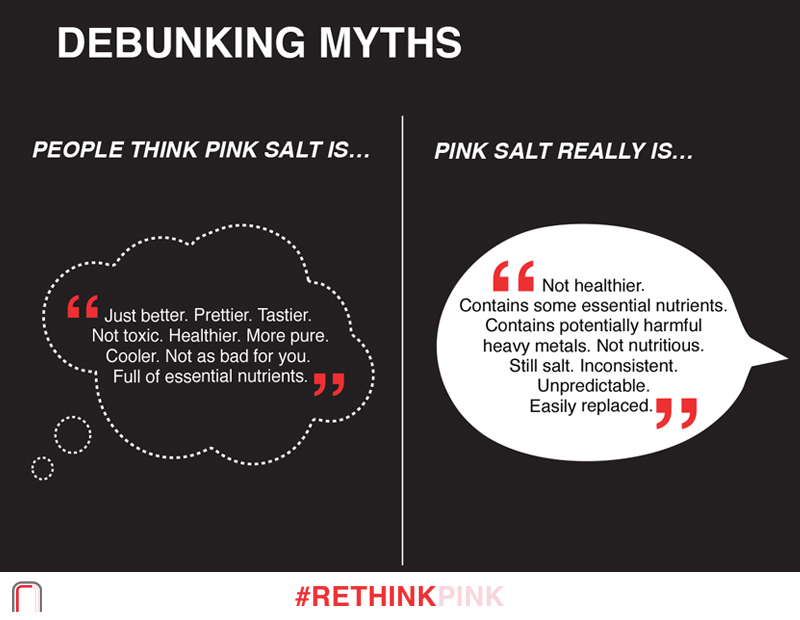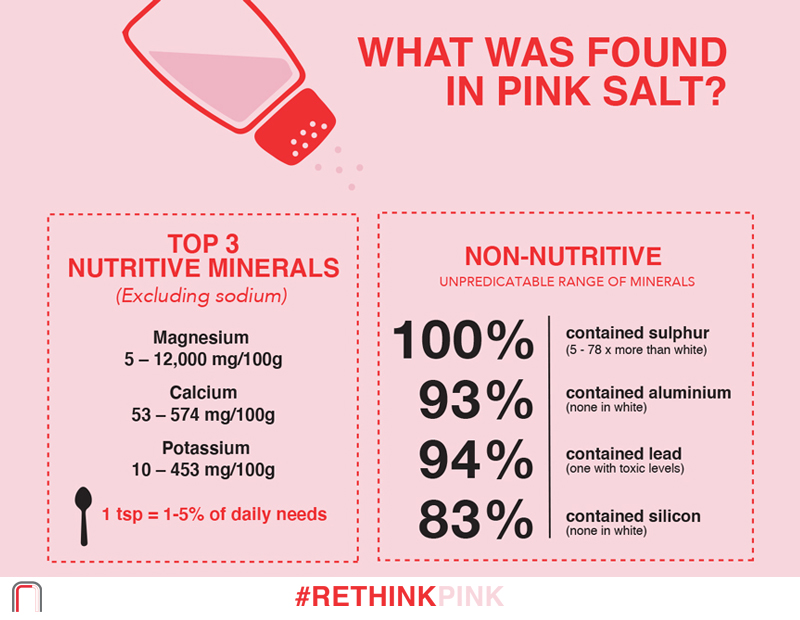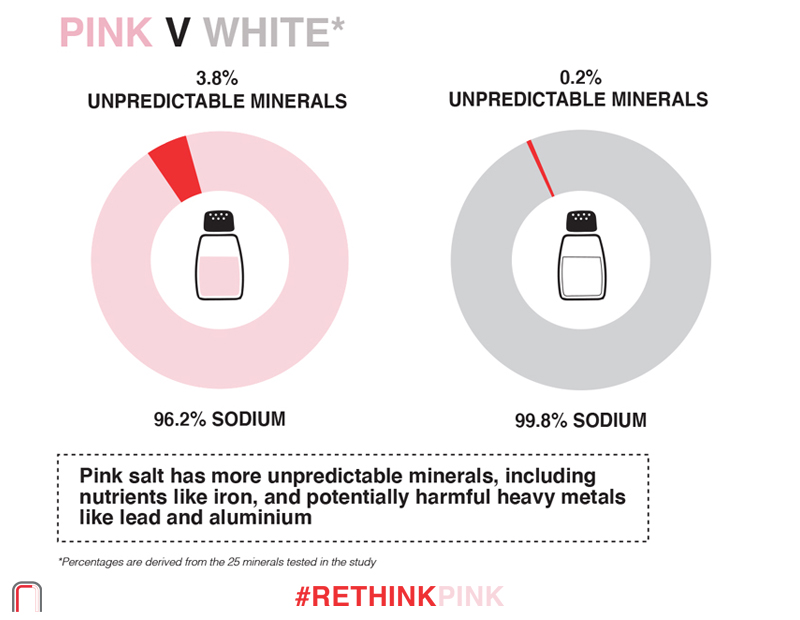Pink salts are NOT healthier for you

I guess you’ve seen those lovely pink Himalayan salts packs. They’ve almost become a designer accessory for the modern kitchen. Well, pretty they may be, healthy they’re not.
The truth about pink salts
Pink salts have grown in popularity and are often marketed for their alleged health benefits and positioned to look more ‘natural' and be nutritionally superior to white salt.
However, a world-first study led by Nutrition Research Australia (NRAUS) – the first of its kind to evaluate the mineral composition of pink salts – has shown that pink salts have only low levels of essential nutrients and a wide variation in the levels of harmful heavy metals such as lead or aluminium.

What the study involved
The researchers tested 31 samples of pink salts available for purchase in Australia in 2018 and compared their results to a control which was an iodized white table salt made by Saxa.
They used mass spectrometry to analyse for all minerals (aluminium, arsenic, barium, boron, cadmium, cadmium, calcium, chromium, cobalt, copper, iron, lead, magnesium, manganese, mercury, molybdenum, nickel, phosphorus, potassium, selenium, silicon, silver, sodium, sulphur, vanadium and zinc).
They also evaluated the colour intensity (no colour, light, medium or dark pink), the form of the salt (finely-ground, flakes, coarse or rock for grinders), and the country of origin (27 originated in the Himalayas, 3 from Australia, 1 from Peru).
The results
The results revealed that pink salts are unpredictable and inconsistent. For instance, there are wide variations in the levels of nutrients found, with iron levels ranging between 0 and 17 mg per 100 grams and calcium levels ranging between 53 and 574 mg per 100 g.
Those pink salt samples with a higher concentration of essential nutrients also had higher levels of heavy metals such as lead, aluminium, cadmium and arsenic
More alarmingly, some pink salt samples contained up to 19 mg per 100 g of aluminium and up to 0.26 mg per 100 g of lead, with one sample exceeding the national contaminant level – both aluminium and lead are heavy metals that are harmful if consumed long-term in excess.
However, all the Australian-sourced pink salts showed lower levels of both essential nutrients and non-nutritive metals, including heavy metals. This is good news if you prefer to buy Australian. You can check out the article in full and check the levels of nutrients and heavy metals in your favourite salt here.
What are the minerals found in pink salts?
 The top three nutrients found in pink salts were:
The top three nutrients found in pink salts were:
- Magnesium
- Calcium
- Potassium
But one teaspoon or 5 grams contributed only between 1 and 5 per cent of daily needs but also contributed 100 per cent of the maximum sodium limit.
Note: only minerals with a Recommended Dietary Intake (RDI) were classified as nutrients.
The top four non-nutritive minerals in pink salts were:
- Sulphur (present in 100 per cent of the samples / at least 5 times more than white)
- Aluminium (present in 93 percent of the samples / not present in white)
- Lead (present in 94 per cent of the samples / not present in white)
- Silicon (present in 83 per cent of samples / not present in white).
Note: minerals without an RDI were classified as non-nutritive.
So, the amounts of minerals are not meaningful and limiting salt intake from all sources will help Australians align with the recommendations from the World Health Organisation as well as our own Dietary Guidelines.
Higher levels of minerals were found in:
- Pink salts in flake form
- Pink salts originating from the Himalaya
- Darker-coloured pink salts
All salts met the FSANZ safe level of metal contaminants with the exception of one sample (the one from Peru) which exceeded the maximum level set for lead which posed a concern for public health.

The bottom line
You would need an exceedingly high intake of pink salt (over 30 grams a day) before you got a decent contribution to your other nutrients such as potassium or magnesium.
Pakistan which mines Himalayan pink salts in the mountainous regions has undergone rapid industrialisation and population explosion so their water supply and soil may be heavily contaminated. This comes through to their products such as the salts.
Rethink your love of pink salt.
Even though sodium is essential, most Australians are having way too much which increases the chance of high blood pressure and the risk of heart disease, which is still our leading cause of death. There are plenty of other ways to flavour your dishes from herbs, spices, lemon juice, mustard, tomatoes, mushrooms and dried seaweed.



